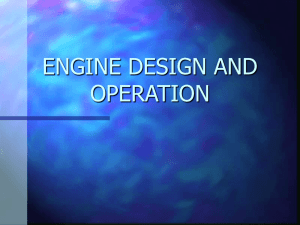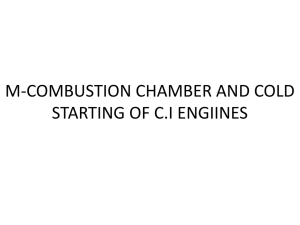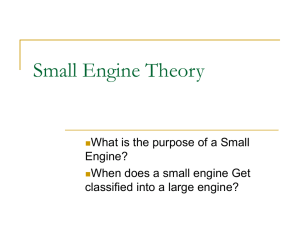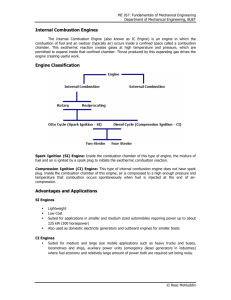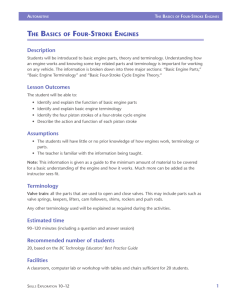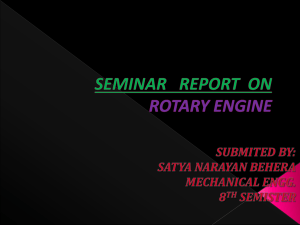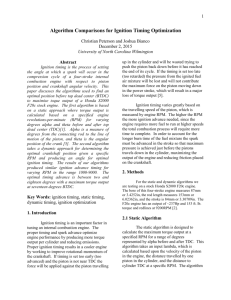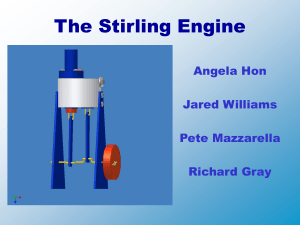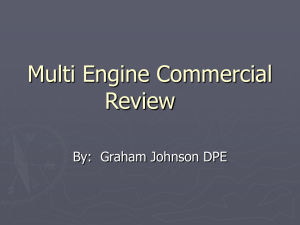Engine Components and Operation
advertisement
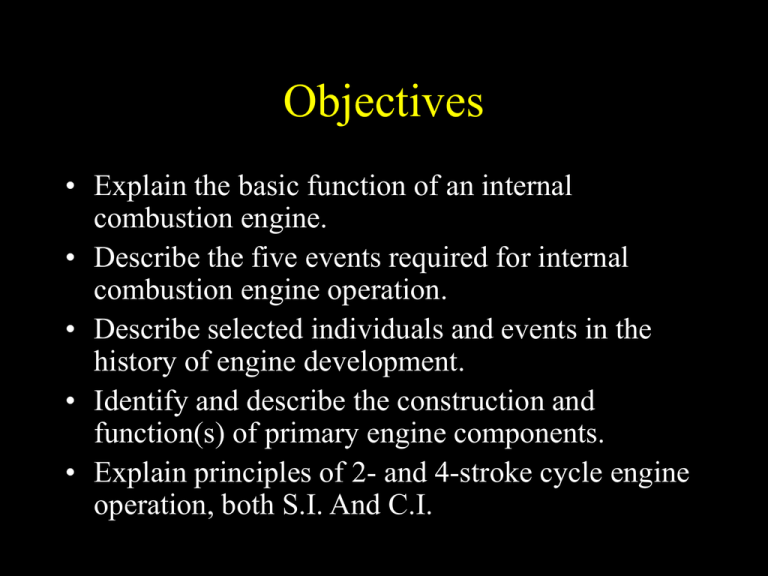
Objectives • Explain the basic function of an internal combustion engine. • Describe the five events required for internal combustion engine operation. • Describe selected individuals and events in the history of engine development. • Identify and describe the construction and function(s) of primary engine components. • Explain principles of 2- and 4-stroke cycle engine operation, both S.I. And C.I. Internal Combustion Engine • Function - Converts potential chemical energy in fuel into heat energy then to mechanical energy to perform useful work. Chemical Heat Mechanical Requirements for I.C. Engine Operation • All Internal combustion engines must carry out five events: – Air-fuel mixture must be brought into the combustion chamber. – Mixture must be compressed. – Mixture must be ignited. – Burning mixture must expand into increasing combustion chamber volume. – Exhaust gasses must be removed. Historical Development of the I.C. Engine • 1862 -- Rochas described the basic principles essential for efficient engine operation. • 1878 – Otto built the first successful 4-stroke cycle engine. • 1891 – Day built an improved 2-stroke cycle engine. • 1892 – Diesel patented the compression-ignition (diesel) engine. • To present – emphasis on improved engine efficiency, through refinement. Engine Components and Functions Name that Engine Part 1 7 2 3 4 5 6 8 9 10 11 12 13 14 15 Name that Engine Part Valve cover Valve spring Valve Piston Connecting rod Engine block Connecting rod cap Rocker arm Push rod Piston pin Valve tappet Camshaft Connecting rod Main journal Oil pan Engine Parts ID Scoring • • • • • • • • 14 - 15 correct – Master Gearhead 12-13 – Gearhead 10 -11 – Mechanic 8 - 9 -- Apprentice Mechanic 6 – 7 – Wrench Turner 4 – 5 – Wrench Loser 2 -- 3 – Jiffy Lube Customer 0 – 1 Can’t Find Jiffy Lube – Looking for Lube in all the Wrong places???? Cylinder Block •“Backbone” of the engine. •Supports / aligns most other components. •Part of basic tractor frame. •Contains: •Cylinders •Coolant passages •Oil passages •Bearings •One-piece, gray cast iron Cylinders • Cylindrical holes in which the pistons reciprocate. • May be: – Enblock – Liners • Wet liners • Dry liners • Cylinder bore – diameter of cylinder Checking Cylinder Condition • During engine overhaul, cylinder is checked for: – Excessive wear (oversize) – Out-of Round – Taper Bearings and Journals Bearing Journal • Bearing – Stationary (nonrotating) surfaces providing support to moving (rotating) component. – Main bearings – Rod bearings – Cam bearings • Journal – Surface of moving component supported by a bearing. Cylinder Head •One-piece castings of iron alloy. •Seals the “top-end” of the combustion chamber. •Contains the valves and the intake and exhaust “ports”. •Head bolts and head gasket ensure air-tight seal of the combustion chamber. •Contains oil and coolant passages. Valve Train • Controls flow into and out of the combustion chamber. – Time and Duration • Tractor engines use “Overhead Valve (OHV)” configuration. • Components – – – – – – – – Camshaft Valve tappets Push rods Rocker arm Valves Valve springs Valve rotators Valve seats Camshaft •Open the intake and exhaust valves at correct time and for correct duration. •Driven by gear (or chain) from the crankshaft. •2:1 crankshaft to camshaft gear ratio. Lift Nose Base circle Cam Profile Valves • Each cylinder will have: – Intake valve – Exhaust valve • Valve nomenclature – – – – – Head Margin Face Tulip Stem Piston and Rings • Piston – Forms the “moveable bottom’ of the combustion chamber. • Iron alloy or aluminum • Rings – Compression – Oil-control • Cast iron • Piston pin Know Your Piston! Connecting rod • Connects the piston to the crankshaft • Converts reciprocating piston motion to rotary motion at the crankshaft. • Nomenclature • Drop-forged steel Crankshaft •Works with connecting rod to change reciprocating to rotary motion. •Transmits mechanical energy from the engine. •Made of heat-treated steel alloys. Cylinder Bore •Bore is the diameter of the cylinder Stroke BDC •Linear distance piston travels from Top Dead TDC Stroke Center (TDC) to Bottom Dead Center (BDC). Piston and Engine Displacement TDC BDC Volume "displaced" as Piston moves from BDC to TDC Compression Ratio BDC TDC •Ratio of “Total Volume” in cylinder at BDC to TDC. •C.R. = (Pd + ClV) / ClV Compression Ratio and Gasoline Octane Rating BDC TDC CR Octane Rating •5:1 73 •6:1 81 •7:1 87 •8:1 91 •10:1 98 •11:1 100 •12:1 102 Compression Ratio and Theoretical Otto Cycle Efficiency BDC TDC 4-Stroke Cycle Engine Operation • 4-stroke cycle engines require four strokes of the piston to complete the five events necessary for engine operation. – 1 piston stroke = ½ crankshaft revolution. – 4 piston strokes = 2 crankshaft revolutions. 4-Stroke Cycle Engine Operation • Intake Stroke – Intake valve open. – Piston moves down (TDC to BDC) in cylinder. – Low pressure is created in cylinder. – Air is brought into the combustion chamber due to pressure differences. 4-Stroke Cycle Engine Operation • Compression Stroke – Both valves closed. – Piston moves from BDC to TDC – Air in combustion chamber is compressed, raising its temperature. – Near TDC of Compression stroke, diesel fuel is injected into the combustion chamber. 4-Stroke Cycle Engine Operation • Power Stroke – Both valves are closed – Air-fuel mixture burns rapidly – Expansion of the burning air-fuel mix applies force to the head of the piston – Piston is driven down in the cylinder. 4-Stroke Cycle Engine Operation • Exhaust Stroke – Piston moves from BDC to TDC. – Exhaust valve is open. – Burnt air-fuel mixture is scavenged from combustion chamber. 4-Stroke Cycle C.I. Engine Comparison of 4-Stroke Cycle for C.I. And S.I. Engines Stroke C.I. (Diesel) S.I. (Gasoline) Intake Air only Air-fuel mix Compression C.R. > 14:1 Temp > 729 oF C.R. 6:1 – 12:1 Power No difference Exhaust No difference Two-Stroke Cycle Engines Two-Stroke Cycle Engine Operation Comparison of Two-Stroke vs. Four-Stroke Cycle Engines
